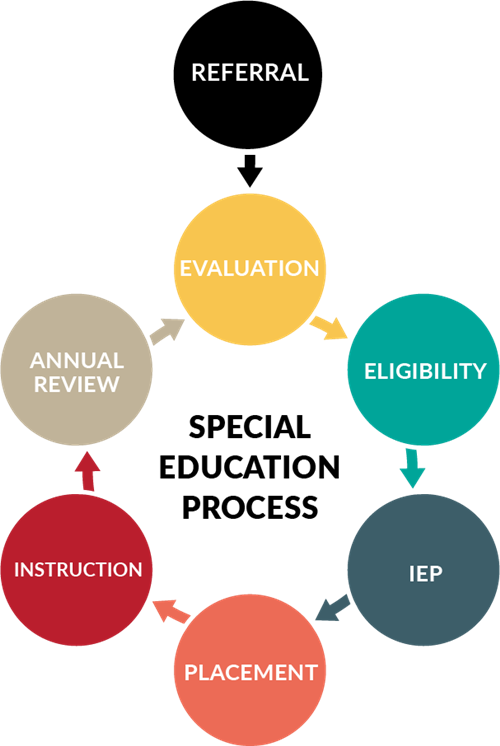
Referral, Evaluation and Eligibility
-
Child Find
Child Find is a set of activities used to identify children from birth to 21 years old who may need special education programs and services. Schools are required to locate, identify, and evaluate all children with disabilities from birth through age 21.The Child Find mandate applies to all children who reside within a State, including children who attend private schools and public schools, highly mobile children, migrant children, homeless children, and children who are wards of the state.Every SELPA and school district is required to have procedures in place to help locate students who may need special education services, and each public school site within the SELPA has information on how to initiate a referral for special education services. If your child is not receiving special education services and you suspect there is a disability, please contact your child's teacher or principal to discuss your concerns. A student may be referred by parents, teachers, and other school staff members, doctors, agency staff, or others. -
Determing Eligibility
Special Education Programs and Related Services are available for students identified as handicapped from birth through age twenty-one. These programs and services are provided to students who are deemed eligible under one of the following handicapping condition categories:
- Autism
- Deaf/Blindness
- Deafness
- Emotional Disturbance
- Established Medical Disability (3-5-Years-old)
- Hard of Hearing
- Intellectual Disabilities
- Multiple Disability
- Orthopedic Impairment
- Other Health Impairment
- Speech/Language Impairment
- Specific Learning Disability
- Traumatic Brain Injury
- Visual Impairment
All determinations of eligibility, placement and services are an Individual Education Program (iep) team decision, based upon the results of a multi-disciplinary team evaluation.
-
Who's Eligible for Services?
A student, ages 3 through 22, having one or more of the thirteen Federally defined disabling conditions that adversely affect his or her educational performance, may be eligible to receive special education services.
-
Evaluation (Assessment)
A school representative will contact the parent/guardian and:- Review the reasons for assessment.
- Describe the materials and procedures which will be used to obtain information about the child.
- Explain the rights of the parent/guardian and school district related to assessment.
- Determine the student's primary language and proficiency.
- Describe alternate means as appropriate.
- Obtain written consent for release of confidential information
Arrangements will be made to have the child's needs evaluated. This will be done through testing and conferences held among those who have worked with the child's teachers, nurses, counselors, therapists, psychologists and others. Written consent and participation will be needed, and evaluation results will be shared with you.This evaluation has three major purposes:- To assess needs and gather information about the student.
- To determine eligibility for special education programs and services.
- To recommend the appropriate special education programs and/or related services for the student or other program modifications.
-
Assessment Team Members
Assessment team members can include:
Parents who: (1) review and approve the Assessment Plan, (2) provide health and developmental history, (3) describe the child's responses to tasks and social interactions in the non-schools settings of home, neighborhood and community, and (4) release existing assessment reports if available, including physician's reports.Teachers who inform the team about the student's academic achievement, physical/motor performance, and social behavior in the classroom.
District Nurse who reviews the student's medical background and physical development, as well as screens hearing and vision.
Speech-Language Pathologist who provides relevant information on speech and language development (if a need is suspected in this area).
School Psychologist who examines the student's social, emotional, academic, and intellectual development.
Adaptive PE Teacher or Occupational Therapist who examines the student's physical and sensory/motor development (if a need is suspected in these areas).
-
When is an assessment required?
An assessment is required in the following instances:
- Prior to initial placement in special education program.
- Whenever any significant change in the student’s special education placement occurs, including addition of new services, and discontinuation of existing services.
- If the team of qualified assessors, which includes the parent(s), determine that additional data are needed in reviewing whether the student continues to need special education and related services.
- Every three (3) years or more frequently, if conditions warrant or if the student’s parent(s) or teacher requests a new assessment when a new Individualized Education Program (IEP) is to be developed.

Placement (Least Restrictive Environment)
-
Least Restrictive Environment (LRE)
To the maximum extent appropriate, children with disabilities will be educated with children who are not disabled and special classes, separate schooling, or other removal of children with disabilities from the general education program will occur only when the nature or severity of the disability is such that education in regular classes with the use of supplementary aides and services cannot be achieved satisfactorily.
The LRE continuum of services is a range of educational settings that can be chosen in order to satisfy the IEP. This setting exists on a continuum because it is used to meet the individual and differentiated needs of the disabled student. Having multiple options available is needed to ensure that a child with a disability can be served in a setting that adequately sets them up for success.
-
General Education
- General education classroom
- General education classroom with supplemental aides and services
- General education classroom with related services
- General education classroom with consultation and/or collaboration with special education staff -
Resource Specialist Program (SAI)
- General education classroom with Specialized Academic Instruction delivered in-class (push-in services)
- General education classroom with Specialized Academic Instruction in a separate class (pull-out services) -
Special Day Class (Preschool through 12th grade) Mild/Moderate Disabilities
- Separate classroom with Specialized Academic Instruction for the majority of the school day
- Access to modified general education curriculum aligned to Common Core State Standards -
Special Day Class (Preschool through 12th grade) Moderate/Severe Disabilities
- Separate classroom with Specialized Academic Instruction for the majority of the school day utilizing alternative curriculum standards
- Access to an alternative curriculum aligned to Common Core State Standards -
Adult Transition Program (Ages 18 - 22)
- Vocational training in the community
- Independent Living Skills
- Career Awareness
- Work-Based Learning Experience
- Job Coaching -
Non-Public School (NPS)
- Qualified students may receive educational services in a non-public school setting if neither the serving school district or county office of education can provide an appropriate program.
-
Alternative Education
- Alternative education programs include community school, juvenile court schools, independent study, home instruction, and hospital setting
-
Home and Hospital
- Special education services provided to eligible students in a home teaching program or hospital setting
- Consideration for home and hospital instruction must include a medical report from an attending physician or a report from a psychologist stating the diagnosing condition and certifying that the severity of the condition prevents the student from attending a less restrictive environment.
- Home and hospital instruction is a temporary placement typically lasting a minimum of three weeks and a maximum of 18 weeks.

